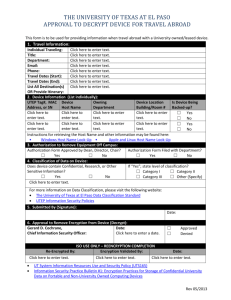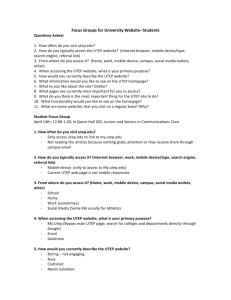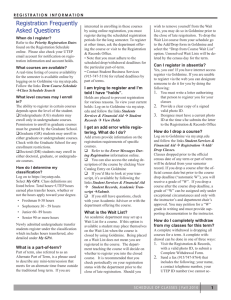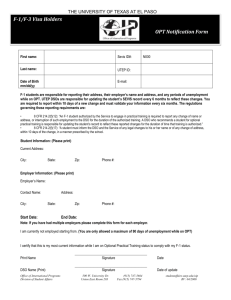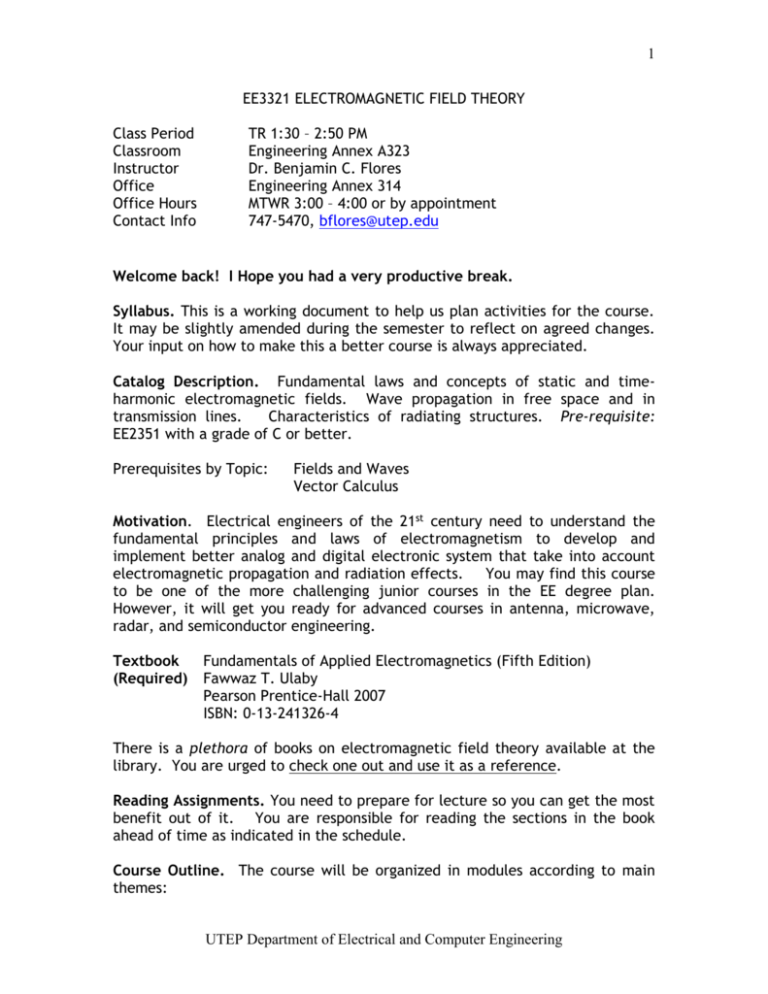
1
EE3321 ELECTROMAGNETIC FIELD THEORY
Class Period
Classroom
Instructor
Office
Office Hours
Contact Info
TR 1:30 – 2:50 PM
Engineering Annex A323
Dr. Benjamin C. Flores
Engineering Annex 314
MTWR 3:00 – 4:00 or by appointment
747-5470, bflores@utep.edu
Welcome back! I Hope you had a very productive break.
Syllabus. This is a working document to help us plan activities for the course.
It may be slightly amended during the semester to reflect on agreed changes.
Your input on how to make this a better course is always appreciated.
Catalog Description. Fundamental laws and concepts of static and timeharmonic electromagnetic fields. Wave propagation in free space and in
transmission lines.
Characteristics of radiating structures. Pre-requisite:
EE2351 with a grade of C or better.
Prerequisites by Topic:
Fields and Waves
Vector Calculus
Motivation. Electrical engineers of the 21st century need to understand the
fundamental principles and laws of electromagnetism to develop and
implement better analog and digital electronic system that take into account
electromagnetic propagation and radiation effects. You may find this course
to be one of the more challenging junior courses in the EE degree plan.
However, it will get you ready for advanced courses in antenna, microwave,
radar, and semiconductor engineering.
Textbook
(Required)
Fundamentals of Applied Electromagnetics (Fifth Edition)
Fawwaz T. Ulaby
Pearson Prentice-Hall 2007
ISBN: 0-13-241326-4
There is a plethora of books on electromagnetic field theory available at the
library. You are urged to check one out and use it as a reference.
Reading Assignments. You need to prepare for lecture so you can get the most
benefit out of it. You are responsible for reading the sections in the book
ahead of time as indicated in the schedule.
Course Outline. The course will be organized in modules according to main
themes:
UTEP Department of Electrical and Computer Engineering
2
Module
Module
Module
Module
1
2
3
4
Vector Analysis
Electrostatics
Magnetostatics
Wave Propagation and Transmission Lines
Course Outcomes. By the end of the semester you will demonstrate the ability
to:
1. Apply vector calculus to understand the behavior of static electric fields
in standard configurations
2. Apply vector calculus to understand the behavior of static magnetic
fields in standard configurations
3. Describe and analyze electromagnetic wave propagation in free-space
4. Describe and analyze transmission lines
5. Work in a small team using a cooperative learning rules
6. Communicate electromagnetic concepts both orally and in writing
Contribution to Professional Component
EE3321 is a junior core course that builds on topics covered primarily in
sophomore physics and electrical engineering courses.
Relationship to (ABET) Program Outcomes
The following four program outcomes are addressed in this course:
Ability to apply knowledge of mathematics, science, and engineering. Students
use concepts from physics and calculus in the analysis of electromagnetic
problems (course outcomes 1, 2)
Ability to identify, formulate and solve engineering problems. Students solve
problems and perform simulations of field distributions and radiation patterns
(course outcomes 1, 2, 3, 4).
Ability to function in multidisciplinary teams. Students are assigned to study
in base teams from the start of the semester and are required to follow
cooperative learning rules of engagement (course outcomes 2, 5).
Ability to communicate effectively. Students solve problems, give oral
individual presentations of solved problems, and write reports of individual and
team projects (course outcome 2, 4, 6).
UTEP Department of Electrical and Computer Engineering
3
Mandatory Attendance. I reserve the right to withdraw any student who has
more than four unexcused absences.
Studying. Traditional wisdom says that you should study 9 hours per week for
this course (3 hours for each hour of lecture). I encourage you to form study
groups of 4 people. You may get together to discuss homework problems and
computer assignments. At the same time, I expect a truly individual effort to
be reflected in your work.
Course Portfolio. You are required to make a course portfolio for the course.
The portfolio must include a copy of your latest resume, syllabus, handouts,
tests, homework, and project reports. Keep the portfolio well organized as it
is a reflection of the best work you can produce. The portfolio is due on the
day of the final. You must pick up your portfolio by the end of the semester.
Failure to do may result in a lower letter grade.
Tests and Final Examination. There will be four tests during the semester.
Typically, a test will have three problems. The first problem will test your
ability to remember and understand information. The second problem will test
you on your ability to apply and analyze information. The third problem will
test you on your analysis and synthesis abilities. A score of 70% or higher on
each problem is considering “passing”.
There will be one makeup opportunity for each test. You are allowed to work
on a problem for which your score on the original test is lower than 70%.
Your grade for any given test is the average of the passing scores.
The final examination will be an opportunity to challenge any problem scores
you wish to improve upon.
Grading. The course grade will be based on 4 tests, an individual project, a
team project report, a student portfolio and a final examination. The
following point scheme will be used to determine your final grade.
Test 1
Test 2
Test 3
Test 4
Individual Project
Team Project
150 points
150 points
150 points
150 points
150 points
150 points
Student Portfolio
100 points
Total
1000 points
Transmission line analysis
Electromagnet
UTEP Department of Electrical and Computer Engineering
4
The final letter grade scale is as follows:
A
B
C
D
F
1000 – 900 points
899 – 800
799 – 700
699 – 600
Below 600
Student grades are protected by the Privacy Act of 1974. Protect your rights!
Course Materials. The following items are required for the course:
3 ring binder
TI calculator or equivalent
Engineering graph paper for homework assignments
Academic Integrity and Professional Ethics. You must abide by professional
and academic integrity rules. I expect nothing but the best from you. I will
not hesitate to report all cases of misconduct to the Dean of Students and the
Assistant Dean of Engineering. Check the Dean of Student’s website for UTEP’s
policy on academic dishonesty:
http://www.utep.edu/dos/acadintg.htm
Also, check the IEEE website for information on our code of ethics:
http://www.ieee.org/about/whatis/code.html
Learning Disabilities.
The UTEP Disabled Student Services Office was
established for the purpose of providing appropriate and reasonable
accommodations as mandated in Section 504 of the Rehabilitation Act of 1973
and the Americans with Disabilities Act (ADA). If you have needs regarding
learning disabilities, please help me to help you by reporting those needs the
first week of classes.
Additional information is available at
http://www.utep.edu/dsso/
Discrimination. Discrimination on the basis of age, gender, color, ethnicity,
national origin, religion, disability, or sexual orientation will not be tolerated.
Members of the UTEP community are protected from discrimination and
harassment by State and Federal Laws.
UTEP Department of Electrical and Computer Engineering
5
Class Participation
Show up on time. Late comers may not be allowed in class.
Ask questions. The only bad question is the one that you never ask.
Bring your book to class.
Learn from your teammates and be loyal to the team.
Etiquette
Treat e-mail correspondence as a professional exchange of information.
Turn in homework assignments on time.
Turn off cell phones, beepers, i-pods and other electronic items during
the class period.
SEVEN HABITS OF SUCCESSFUL STUDENTS
1.
2.
3.
4.
5.
6.
7.
Seek to understand and be understood
Read the assigned material before class
Attend and participate in class
Review your class notes
Do your homework and turn it in - on time
Study with teammates
Start preparing for an exam at least one week ahead
UTEP Department of Electrical and Computer Engineering
6
What do these figures represent?
____
____
____
____
a)
b)
c)
d)
Magnetic Field due to current flow
Propagating Electromagnetic Wave
Magnetic Dipole
Electric Dipole
Syllabus Prepared by Prof. Benjamin C. Flores
UTEP Department of Electrical and Computer Engineering
7
SCHEDULE
Date
Lecture
Description
Reading
Assignment
Lesson 0
Welcome
Syllabus
Waves
Preface
S3-1, S3-2,
TEST
Coordinate Systems
Dot and Cross Products
Coordinate Transformations
Gradient, Laplacian Operator
Divergence, Curl
Stokes Theorem
Module 1
Lesson 5
Electric Field
Lesson 6
Charge and Current Density
S1-2.2, S4-1
S4-3
S4-2
Lesson 7
Gauss’s Law
S4-4
Lesson 8
S4-5
Lesson 9
Potential
Poisson’s Equation
Capacitance
TEST
Module 2
Lesson 10
Magnetic Field
S1-2.3
Lesson 11
Lorentz’ Force
S5-1
Lesson 12
Biot-Savart’s Law
S5-2
Lesson 13
Ampere’s Law
S5-3, S5-4
Lesson 14
S5-8
S6-1, S6-2
Review
Faraday’s Law
Inductance
Module 3
TEST
Module 3
Lesson 15
Harmonic Fields and Phasors
Maxwell’s Equations
Lesson 1
Lesson 2
Lesson 3
Lesson 4
Chapter 1
S3-3, S3-4
S3-7
S3-5, S3-6
S4-10
S1-6, S7-1
UTEP Department of Electrical and Computer Engineering
8
Lesson 16
Wave Propagation
S7-2
Lesson 17
Normal Incidence
S8-1
Lesson 18
Final Project Discussion
Lesson 19
Oblique Incidence
S8-2, S8-4
Lesson 20
Telegraph Equations
Lesson 21
Voltage Standing Wave Ratio
S2-1, S2-2
S2-3, S2-4
S2-5
Lesson 22
Input Impedance
TEST
Module 4
Lesson 23
Presentations
Lesson 24
Presentations
Lesson 25
Comprehensive Review
S2-6, S2-7
S2-8
FINAL EXAM
UTEP Department of Electrical and Computer Engineering


